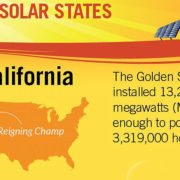California Generates Enough Solar Power to Meet Half Its Energy Needs
In a state with a population more than 30 times greater than that of Hawai’i, California is writing the how-to book on converting to a clean and sustainable energy-based economy. Are Hawai’i lawmakers, regulators, and Hawaiian Electric paying attention?
California Gov. Jerry Brown (D) took a shot last week at Sec. of Energy Rick Perry, a former Republican governor of Texas. Remarking on Perry’s view of Texas as an energy powerhouse, Brown said, “We’ve got more sun than you’ve got oil.”
The state’s goal to generate 50 percent of its power from renewables by 2030 – for short period on March 3, 2017 …it did just that!
Recent data shows California coming through. The state briefly generated enough solar power to meet nearly half of the state’s electricity needs, according to data from the largest grid operator in the state, California ISO.
Around midday on March 3, demand reached around 29 Gigawatts (GW), while solar was providing nearly 14 GW of generation—some 9 GW from utility-scale arrays and another 5 GW or so from rooftops and parking lot canopies around the state.
Renewables are having a big moment. Solar is getting cheaper and cheaper, spurring Californians to set up photovoltaic panels on homes, businesses and empty lots across the state.
“It’s remarkable that over a third of the solar power generated in California comes from smaller rooftop systems, meaning hundreds of thousands of homeowners are reaping the economic value generated from harnessing the sun rather than the state’s big utility companies,” said Amit Ronen, director of the GW Solar Institute.
But while these numbers are a rough approximation, they illustrate the incredible growth of renewable energy. They also highlight the central challenge of integrating solar into the power grid.
Every year, California generates more and more power from solar, exacerbating that midday dip in net power demand. This is problematic, because it’s expensive to ramp up power generation from coal- and gas-fired power plants at dusk.
Fortunately, there are ways to flatten the so-called duck curve by building out transmission lines to carry solar energy over state lines would broaden the demand; installing grid-enabled appliances that shift demand to the middle of the day; or deploying battery storage, like the Tesla Powerwall, that can store excess generation during the day and discharge it in the evening.
“We still need to make significant investments in energy storage technologies that will allow us to bank solar energy when it’s being made so that it can be used whenever we need it, even at night,” Ronen said.
As part of that effort, legislators are looking for ways to better integrate solar energy into the power grid—to drive down costs, improve performance and flatten ducks, wherever they may quack. So, in September, California passed four bills to expand the use of energy storage.
U.S. Supreme Court Justice Louis Brandeis once described the states as laboratories of democracy. They are also laboratories for energy innovation. As the Trump Administration pushes the federal government backwards on renewable energy and climate, California and other progressive states, like Hawai’i, are pushing ahead, providing a model for the rest of country.
See “Past Forums” for additional topic and reference information… “What’s Ahead For HELCO and Hawaii’s Clean Energy Future”, September 15, 2016 — and “Energy Independence, Hawai’i Style”, September 17, 2015,




Leave a Reply
Join the Community discussion now - your email address will not be published, remains secure and confidential. Mahalo.